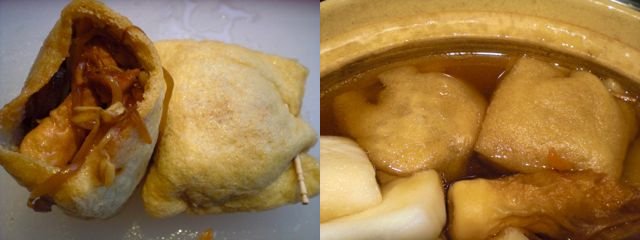We were having some very cold and windy days with a bit of snow (just a dusting with some wind-blown snow accumulation). We also had two small abura-age 油揚げ or deep fried tofu pouches left after making inarisuzhi いなり寿司. I decide to make a simplified version of Japanese winter stew or oden おでん. Please see more information in my previosu post for oden. Instead of the usual mochi-kin 餅巾 or mochi rice case in abura-age, I thought I would make pouches stuffed with pork, onion and bean sprouts. Especially since I had leftover blanched bean sprouts from making
cellophane noodle salad. Whenever you stuff the abura-age pouch, the dish is caled "kinchaku" 巾着 which is the name for a traditional Japanese pouch. After I started the preparation, I realized I did not have any pork but I had two bone-in skin-on split chicken breasts which needed to be dispatched soon--before they went bad. I removed the breasts and two tenderloins. I made the breasts into
microwave "sakamushi" 酒蒸し chicken. I made the stuffing for the tofu pouches from the chicken tenderloins adding shiitake and bean sprouts. The remaining breast bones were used to make the broth for the oden.
Here is a serving of oden; the stuffed pouch is in the foreground accompanied by diakon, potato, carrot, quail eggs, freeze-dried tofu or shimi-dufu, chikuwa and hanpenn. I admit this does not look particularly photogenic.
Revealing the content of the pouch.
Broth: I took a shortcut and used a dashi pack with dried fish, bonito flakes, kelp. I also added the bones from the chicken breasts as well (which was not the usual way of making broth for oden). In a pot, I added about 4 cups of water and a dashi pack. After simmering for 5 minutes, I added the chicken bones and simmered for another 20-30 minutes. I skimmed off any scum that appeared on the surface from the chicken bones. After I removed the bones and dashi pack, I strained the broth. I returned the broth to a donabe earthenware pot. I seasoned it with sake (3 tbp), mirin (3 tbs), soy sauce (2 tbs) and usukuchi 薄口 or light colored soy sauce (2 tbs). Later I adjusted the seasoning by adding a bit more light colored soy sauce.
Stuffed "kinchaku" pouch: The amounts of the ingredients are not accurate since I did not measure. I made just enough to stuff the two rectangular pouches seen below. I sautéed strips of chicken tenderloin (two), fresh mushrooms (5 small, cut into thin strips), blanched bean sprouts (one handful, probably 1/2 cup) in olive oil with a dash of sesame oil. I also added finely chopped ginger (1/8 tsp) and Japanese red pepper flakes. After few minutes of sautéing, I seasoned it with sake (2 tbs) and soy sauce (1 tbs). I braised it until the liquid was also most all gone.
After the stuffing cooled enough to handle, I stuffed the pouches and closed them with a tooth pick (left on the image above). I simmered them in the oden broth with the other items (probably for about one hour. The broth should not boil or even simmer during this process).
Despite the change of plan the midway through, this was not too bad. Although I probably prefer my original intent of bean sprouts, onion, and ground pork, this kinchaku was not bad at all.


No comments:
Post a Comment